Influence of Chinese Migration on Australia's Meat and Seafood Cuisine
VerifiedAdded on 2023/06/08
|11
|2161
|382
AI Summary
This article explores the historical event of Chinese migration to Australia and its impact on the country's meat and seafood cuisine. It discusses changes in cooking techniques and equipment, serving styles, and environmental and political effects. Additionally, it provides a list of current restaurant menus and the top four allergens related to meat and seafood, along with recommendations to minimize allergies.
Contribute Materials
Your contribution can guide someone’s learning journey. Share your
documents today.
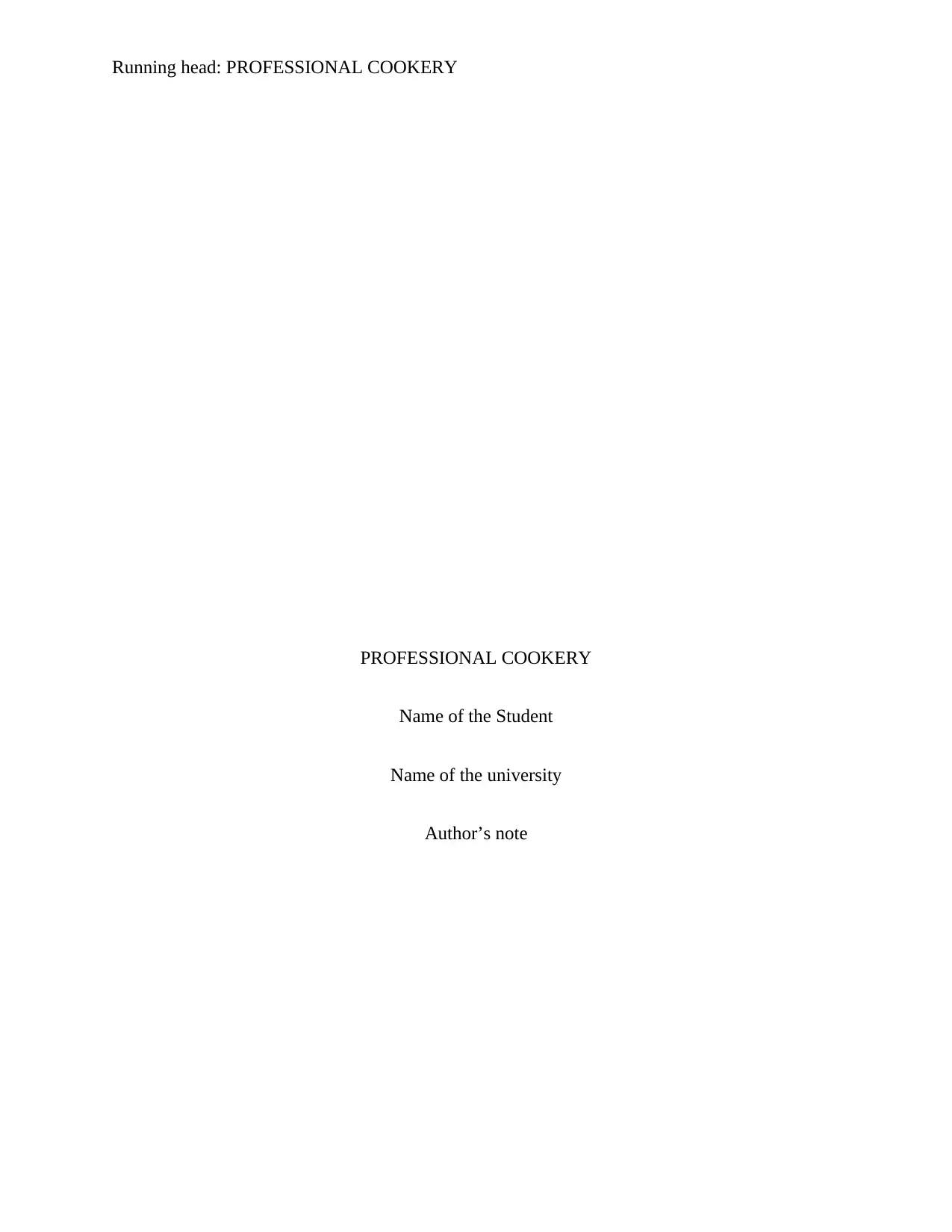
Running head: PROFESSIONAL COOKERY
PROFESSIONAL COOKERY
Name of the Student
Name of the university
Author’s note
PROFESSIONAL COOKERY
Name of the Student
Name of the university
Author’s note
Secure Best Marks with AI Grader
Need help grading? Try our AI Grader for instant feedback on your assignments.
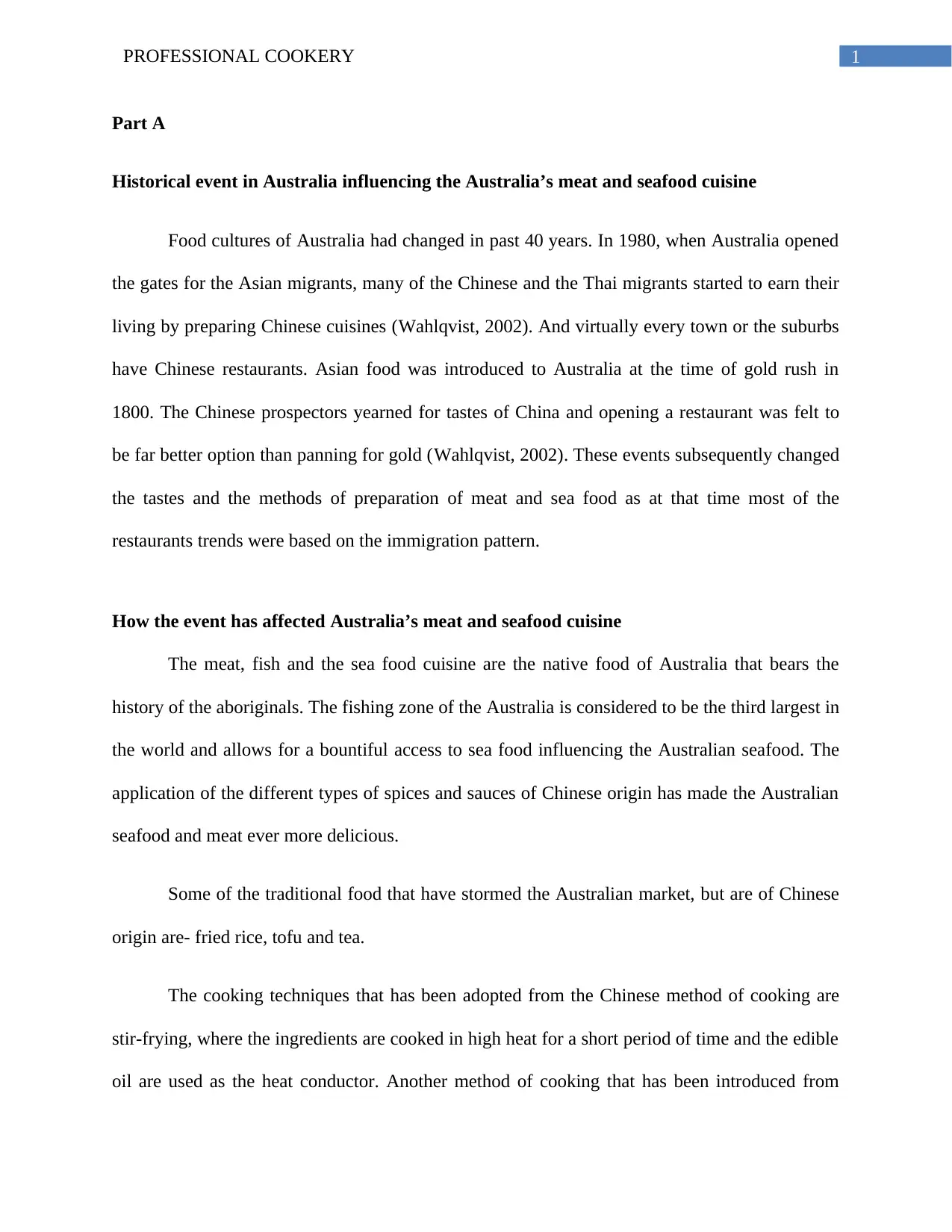
1PROFESSIONAL COOKERY
Part A
Historical event in Australia influencing the Australia’s meat and seafood cuisine
Food cultures of Australia had changed in past 40 years. In 1980, when Australia opened
the gates for the Asian migrants, many of the Chinese and the Thai migrants started to earn their
living by preparing Chinese cuisines (Wahlqvist, 2002). And virtually every town or the suburbs
have Chinese restaurants. Asian food was introduced to Australia at the time of gold rush in
1800. The Chinese prospectors yearned for tastes of China and opening a restaurant was felt to
be far better option than panning for gold (Wahlqvist, 2002). These events subsequently changed
the tastes and the methods of preparation of meat and sea food as at that time most of the
restaurants trends were based on the immigration pattern.
How the event has affected Australia’s meat and seafood cuisine
The meat, fish and the sea food cuisine are the native food of Australia that bears the
history of the aboriginals. The fishing zone of the Australia is considered to be the third largest in
the world and allows for a bountiful access to sea food influencing the Australian seafood. The
application of the different types of spices and sauces of Chinese origin has made the Australian
seafood and meat ever more delicious.
Some of the traditional food that have stormed the Australian market, but are of Chinese
origin are- fried rice, tofu and tea.
The cooking techniques that has been adopted from the Chinese method of cooking are
stir-frying, where the ingredients are cooked in high heat for a short period of time and the edible
oil are used as the heat conductor. Another method of cooking that has been introduced from
Part A
Historical event in Australia influencing the Australia’s meat and seafood cuisine
Food cultures of Australia had changed in past 40 years. In 1980, when Australia opened
the gates for the Asian migrants, many of the Chinese and the Thai migrants started to earn their
living by preparing Chinese cuisines (Wahlqvist, 2002). And virtually every town or the suburbs
have Chinese restaurants. Asian food was introduced to Australia at the time of gold rush in
1800. The Chinese prospectors yearned for tastes of China and opening a restaurant was felt to
be far better option than panning for gold (Wahlqvist, 2002). These events subsequently changed
the tastes and the methods of preparation of meat and sea food as at that time most of the
restaurants trends were based on the immigration pattern.
How the event has affected Australia’s meat and seafood cuisine
The meat, fish and the sea food cuisine are the native food of Australia that bears the
history of the aboriginals. The fishing zone of the Australia is considered to be the third largest in
the world and allows for a bountiful access to sea food influencing the Australian seafood. The
application of the different types of spices and sauces of Chinese origin has made the Australian
seafood and meat ever more delicious.
Some of the traditional food that have stormed the Australian market, but are of Chinese
origin are- fried rice, tofu and tea.
The cooking techniques that has been adopted from the Chinese method of cooking are
stir-frying, where the ingredients are cooked in high heat for a short period of time and the edible
oil are used as the heat conductor. Another method of cooking that has been introduced from
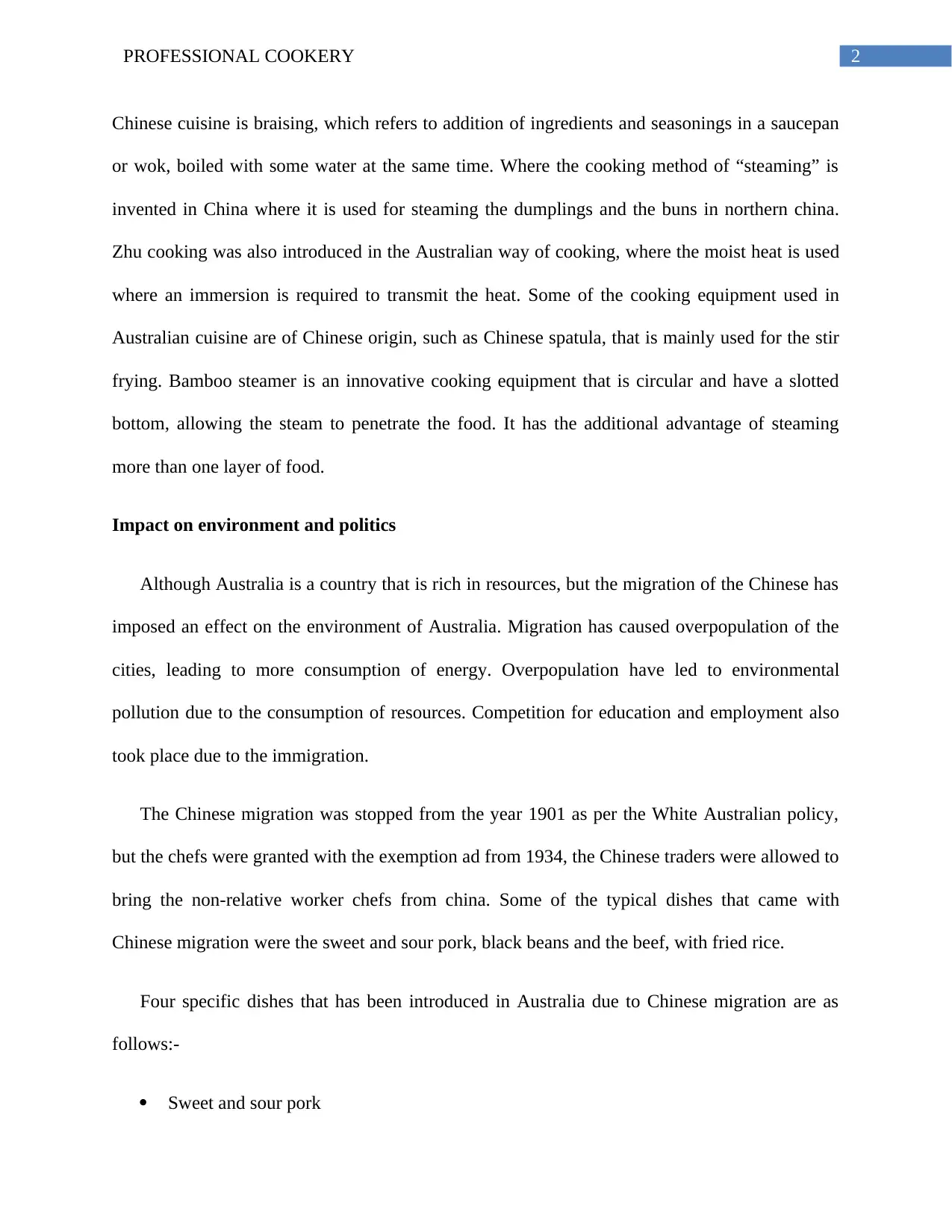
2PROFESSIONAL COOKERY
Chinese cuisine is braising, which refers to addition of ingredients and seasonings in a saucepan
or wok, boiled with some water at the same time. Where the cooking method of “steaming” is
invented in China where it is used for steaming the dumplings and the buns in northern china.
Zhu cooking was also introduced in the Australian way of cooking, where the moist heat is used
where an immersion is required to transmit the heat. Some of the cooking equipment used in
Australian cuisine are of Chinese origin, such as Chinese spatula, that is mainly used for the stir
frying. Bamboo steamer is an innovative cooking equipment that is circular and have a slotted
bottom, allowing the steam to penetrate the food. It has the additional advantage of steaming
more than one layer of food.
Impact on environment and politics
Although Australia is a country that is rich in resources, but the migration of the Chinese has
imposed an effect on the environment of Australia. Migration has caused overpopulation of the
cities, leading to more consumption of energy. Overpopulation have led to environmental
pollution due to the consumption of resources. Competition for education and employment also
took place due to the immigration.
The Chinese migration was stopped from the year 1901 as per the White Australian policy,
but the chefs were granted with the exemption ad from 1934, the Chinese traders were allowed to
bring the non-relative worker chefs from china. Some of the typical dishes that came with
Chinese migration were the sweet and sour pork, black beans and the beef, with fried rice.
Four specific dishes that has been introduced in Australia due to Chinese migration are as
follows:-
Sweet and sour pork
Chinese cuisine is braising, which refers to addition of ingredients and seasonings in a saucepan
or wok, boiled with some water at the same time. Where the cooking method of “steaming” is
invented in China where it is used for steaming the dumplings and the buns in northern china.
Zhu cooking was also introduced in the Australian way of cooking, where the moist heat is used
where an immersion is required to transmit the heat. Some of the cooking equipment used in
Australian cuisine are of Chinese origin, such as Chinese spatula, that is mainly used for the stir
frying. Bamboo steamer is an innovative cooking equipment that is circular and have a slotted
bottom, allowing the steam to penetrate the food. It has the additional advantage of steaming
more than one layer of food.
Impact on environment and politics
Although Australia is a country that is rich in resources, but the migration of the Chinese has
imposed an effect on the environment of Australia. Migration has caused overpopulation of the
cities, leading to more consumption of energy. Overpopulation have led to environmental
pollution due to the consumption of resources. Competition for education and employment also
took place due to the immigration.
The Chinese migration was stopped from the year 1901 as per the White Australian policy,
but the chefs were granted with the exemption ad from 1934, the Chinese traders were allowed to
bring the non-relative worker chefs from china. Some of the typical dishes that came with
Chinese migration were the sweet and sour pork, black beans and the beef, with fried rice.
Four specific dishes that has been introduced in Australia due to Chinese migration are as
follows:-
Sweet and sour pork
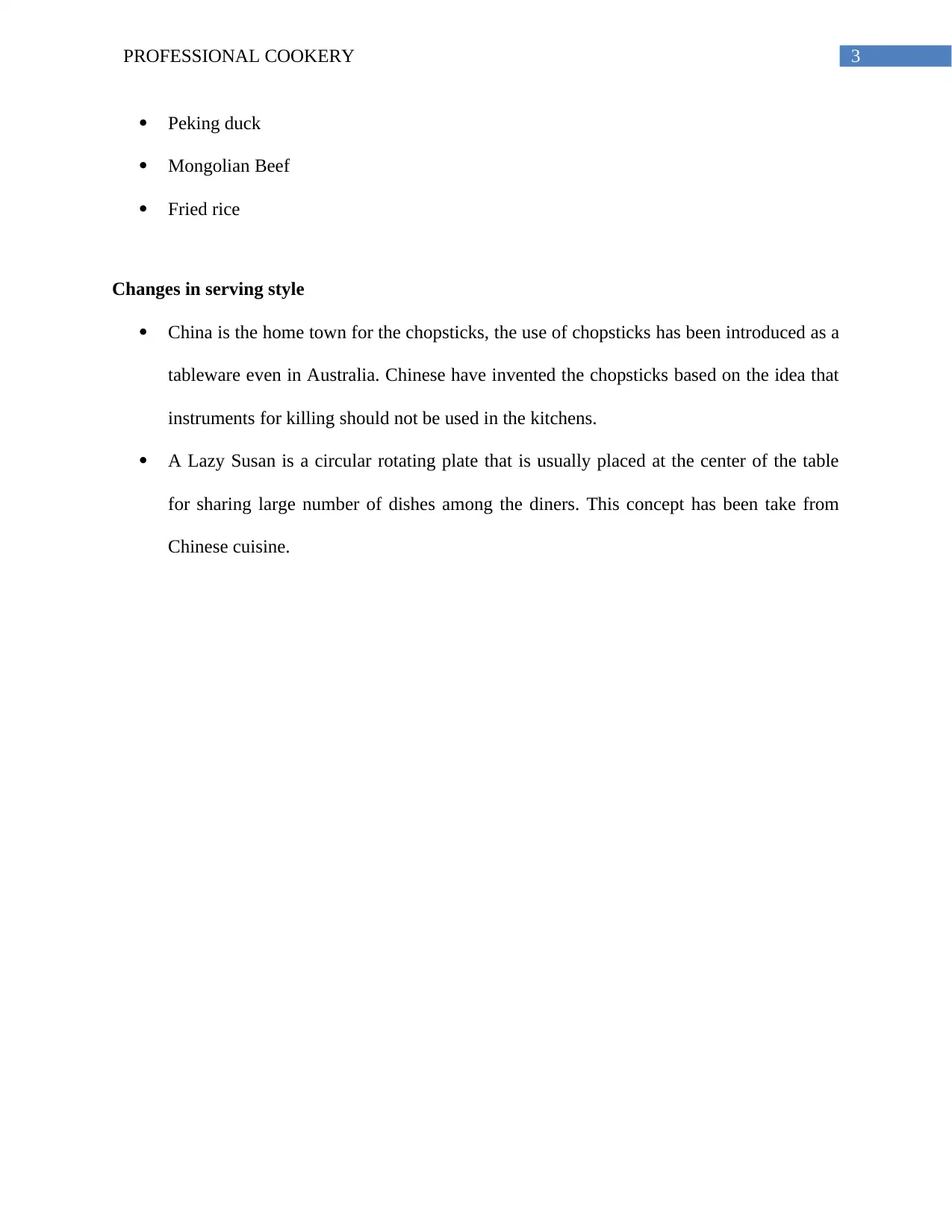
3PROFESSIONAL COOKERY
Peking duck
Mongolian Beef
Fried rice
Changes in serving style
China is the home town for the chopsticks, the use of chopsticks has been introduced as a
tableware even in Australia. Chinese have invented the chopsticks based on the idea that
instruments for killing should not be used in the kitchens.
A Lazy Susan is a circular rotating plate that is usually placed at the center of the table
for sharing large number of dishes among the diners. This concept has been take from
Chinese cuisine.
Peking duck
Mongolian Beef
Fried rice
Changes in serving style
China is the home town for the chopsticks, the use of chopsticks has been introduced as a
tableware even in Australia. Chinese have invented the chopsticks based on the idea that
instruments for killing should not be used in the kitchens.
A Lazy Susan is a circular rotating plate that is usually placed at the center of the table
for sharing large number of dishes among the diners. This concept has been take from
Chinese cuisine.
Secure Best Marks with AI Grader
Need help grading? Try our AI Grader for instant feedback on your assignments.
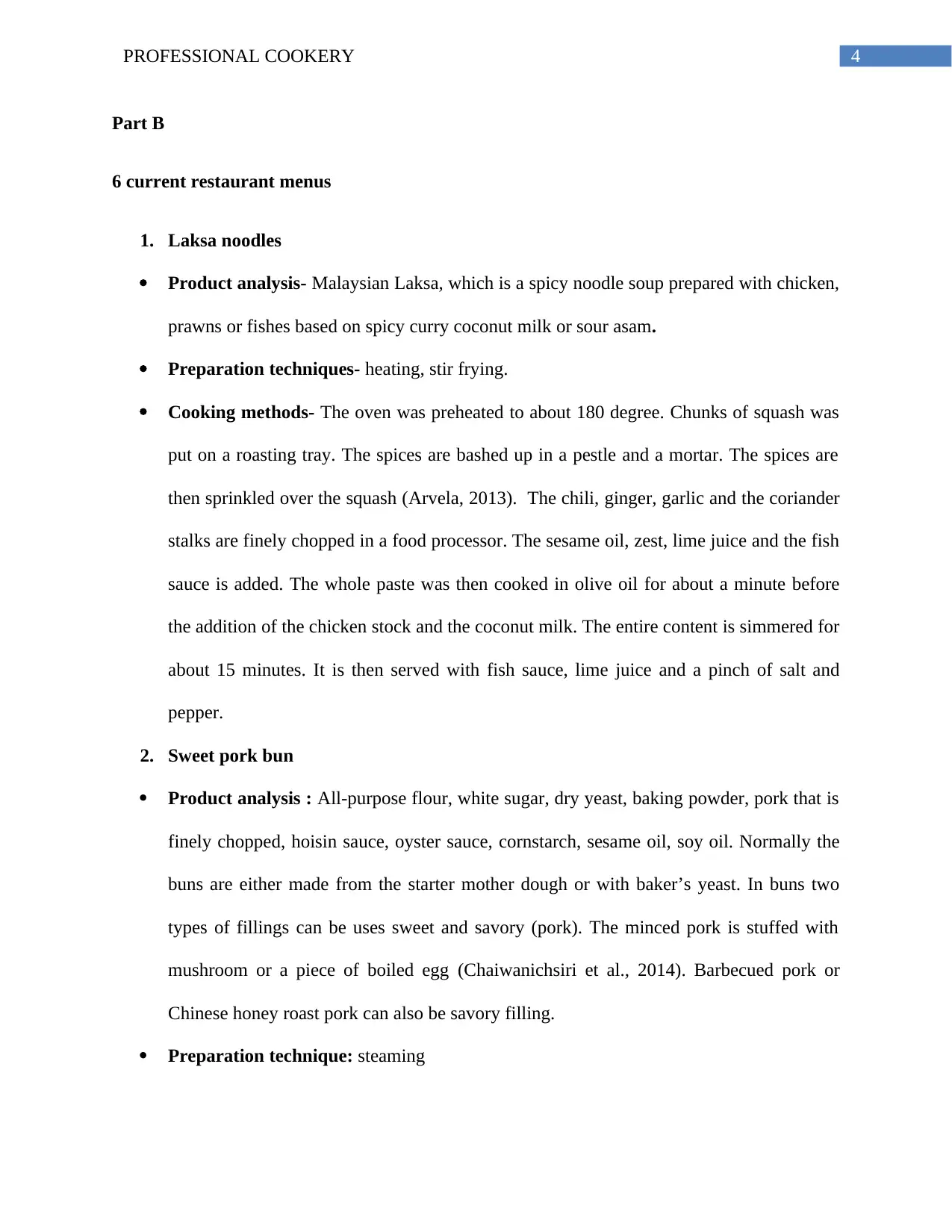
4PROFESSIONAL COOKERY
Part B
6 current restaurant menus
1. Laksa noodles
Product analysis- Malaysian Laksa, which is a spicy noodle soup prepared with chicken,
prawns or fishes based on spicy curry coconut milk or sour asam.
Preparation techniques- heating, stir frying.
Cooking methods- The oven was preheated to about 180 degree. Chunks of squash was
put on a roasting tray. The spices are bashed up in a pestle and a mortar. The spices are
then sprinkled over the squash (Arvela, 2013). The chili, ginger, garlic and the coriander
stalks are finely chopped in a food processor. The sesame oil, zest, lime juice and the fish
sauce is added. The whole paste was then cooked in olive oil for about a minute before
the addition of the chicken stock and the coconut milk. The entire content is simmered for
about 15 minutes. It is then served with fish sauce, lime juice and a pinch of salt and
pepper.
2. Sweet pork bun
Product analysis : All-purpose flour, white sugar, dry yeast, baking powder, pork that is
finely chopped, hoisin sauce, oyster sauce, cornstarch, sesame oil, soy oil. Normally the
buns are either made from the starter mother dough or with baker’s yeast. In buns two
types of fillings can be uses sweet and savory (pork). The minced pork is stuffed with
mushroom or a piece of boiled egg (Chaiwanichsiri et al., 2014). Barbecued pork or
Chinese honey roast pork can also be savory filling.
Preparation technique: steaming
Part B
6 current restaurant menus
1. Laksa noodles
Product analysis- Malaysian Laksa, which is a spicy noodle soup prepared with chicken,
prawns or fishes based on spicy curry coconut milk or sour asam.
Preparation techniques- heating, stir frying.
Cooking methods- The oven was preheated to about 180 degree. Chunks of squash was
put on a roasting tray. The spices are bashed up in a pestle and a mortar. The spices are
then sprinkled over the squash (Arvela, 2013). The chili, ginger, garlic and the coriander
stalks are finely chopped in a food processor. The sesame oil, zest, lime juice and the fish
sauce is added. The whole paste was then cooked in olive oil for about a minute before
the addition of the chicken stock and the coconut milk. The entire content is simmered for
about 15 minutes. It is then served with fish sauce, lime juice and a pinch of salt and
pepper.
2. Sweet pork bun
Product analysis : All-purpose flour, white sugar, dry yeast, baking powder, pork that is
finely chopped, hoisin sauce, oyster sauce, cornstarch, sesame oil, soy oil. Normally the
buns are either made from the starter mother dough or with baker’s yeast. In buns two
types of fillings can be uses sweet and savory (pork). The minced pork is stuffed with
mushroom or a piece of boiled egg (Chaiwanichsiri et al., 2014). Barbecued pork or
Chinese honey roast pork can also be savory filling.
Preparation technique: steaming
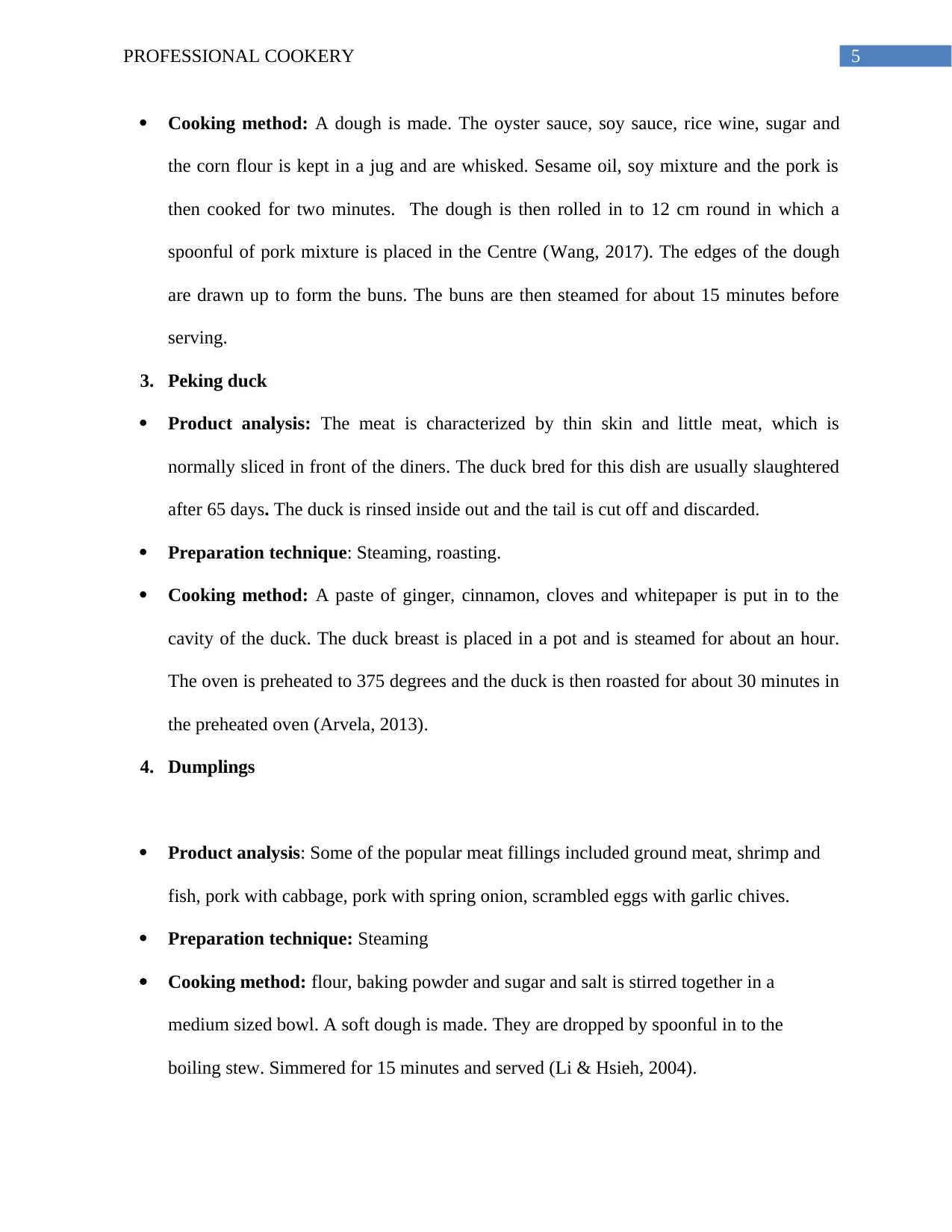
5PROFESSIONAL COOKERY
Cooking method: A dough is made. The oyster sauce, soy sauce, rice wine, sugar and
the corn flour is kept in a jug and are whisked. Sesame oil, soy mixture and the pork is
then cooked for two minutes. The dough is then rolled in to 12 cm round in which a
spoonful of pork mixture is placed in the Centre (Wang, 2017). The edges of the dough
are drawn up to form the buns. The buns are then steamed for about 15 minutes before
serving.
3. Peking duck
Product analysis: The meat is characterized by thin skin and little meat, which is
normally sliced in front of the diners. The duck bred for this dish are usually slaughtered
after 65 days. The duck is rinsed inside out and the tail is cut off and discarded.
Preparation technique: Steaming, roasting.
Cooking method: A paste of ginger, cinnamon, cloves and whitepaper is put in to the
cavity of the duck. The duck breast is placed in a pot and is steamed for about an hour.
The oven is preheated to 375 degrees and the duck is then roasted for about 30 minutes in
the preheated oven (Arvela, 2013).
4. Dumplings
Product analysis: Some of the popular meat fillings included ground meat, shrimp and
fish, pork with cabbage, pork with spring onion, scrambled eggs with garlic chives.
Preparation technique: Steaming
Cooking method: flour, baking powder and sugar and salt is stirred together in a
medium sized bowl. A soft dough is made. They are dropped by spoonful in to the
boiling stew. Simmered for 15 minutes and served (Li & Hsieh, 2004).
Cooking method: A dough is made. The oyster sauce, soy sauce, rice wine, sugar and
the corn flour is kept in a jug and are whisked. Sesame oil, soy mixture and the pork is
then cooked for two minutes. The dough is then rolled in to 12 cm round in which a
spoonful of pork mixture is placed in the Centre (Wang, 2017). The edges of the dough
are drawn up to form the buns. The buns are then steamed for about 15 minutes before
serving.
3. Peking duck
Product analysis: The meat is characterized by thin skin and little meat, which is
normally sliced in front of the diners. The duck bred for this dish are usually slaughtered
after 65 days. The duck is rinsed inside out and the tail is cut off and discarded.
Preparation technique: Steaming, roasting.
Cooking method: A paste of ginger, cinnamon, cloves and whitepaper is put in to the
cavity of the duck. The duck breast is placed in a pot and is steamed for about an hour.
The oven is preheated to 375 degrees and the duck is then roasted for about 30 minutes in
the preheated oven (Arvela, 2013).
4. Dumplings
Product analysis: Some of the popular meat fillings included ground meat, shrimp and
fish, pork with cabbage, pork with spring onion, scrambled eggs with garlic chives.
Preparation technique: Steaming
Cooking method: flour, baking powder and sugar and salt is stirred together in a
medium sized bowl. A soft dough is made. They are dropped by spoonful in to the
boiling stew. Simmered for 15 minutes and served (Li & Hsieh, 2004).
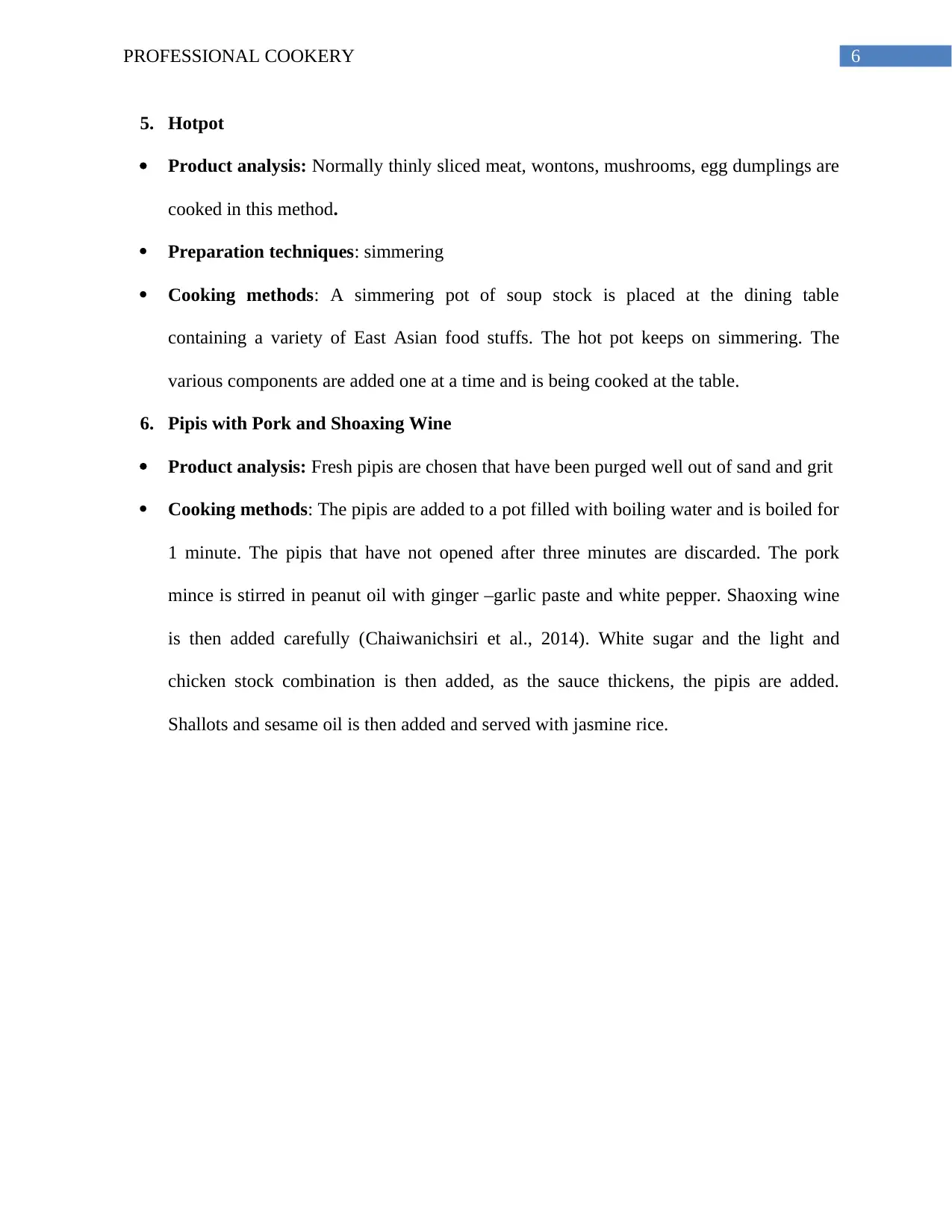
6PROFESSIONAL COOKERY
5. Hotpot
Product analysis: Normally thinly sliced meat, wontons, mushrooms, egg dumplings are
cooked in this method.
Preparation techniques: simmering
Cooking methods: A simmering pot of soup stock is placed at the dining table
containing a variety of East Asian food stuffs. The hot pot keeps on simmering. The
various components are added one at a time and is being cooked at the table.
6. Pipis with Pork and Shoaxing Wine
Product analysis: Fresh pipis are chosen that have been purged well out of sand and grit
Cooking methods: The pipis are added to a pot filled with boiling water and is boiled for
1 minute. The pipis that have not opened after three minutes are discarded. The pork
mince is stirred in peanut oil with ginger –garlic paste and white pepper. Shaoxing wine
is then added carefully (Chaiwanichsiri et al., 2014). White sugar and the light and
chicken stock combination is then added, as the sauce thickens, the pipis are added.
Shallots and sesame oil is then added and served with jasmine rice.
5. Hotpot
Product analysis: Normally thinly sliced meat, wontons, mushrooms, egg dumplings are
cooked in this method.
Preparation techniques: simmering
Cooking methods: A simmering pot of soup stock is placed at the dining table
containing a variety of East Asian food stuffs. The hot pot keeps on simmering. The
various components are added one at a time and is being cooked at the table.
6. Pipis with Pork and Shoaxing Wine
Product analysis: Fresh pipis are chosen that have been purged well out of sand and grit
Cooking methods: The pipis are added to a pot filled with boiling water and is boiled for
1 minute. The pipis that have not opened after three minutes are discarded. The pork
mince is stirred in peanut oil with ginger –garlic paste and white pepper. Shaoxing wine
is then added carefully (Chaiwanichsiri et al., 2014). White sugar and the light and
chicken stock combination is then added, as the sauce thickens, the pipis are added.
Shallots and sesame oil is then added and served with jasmine rice.
Paraphrase This Document
Need a fresh take? Get an instant paraphrase of this document with our AI Paraphraser
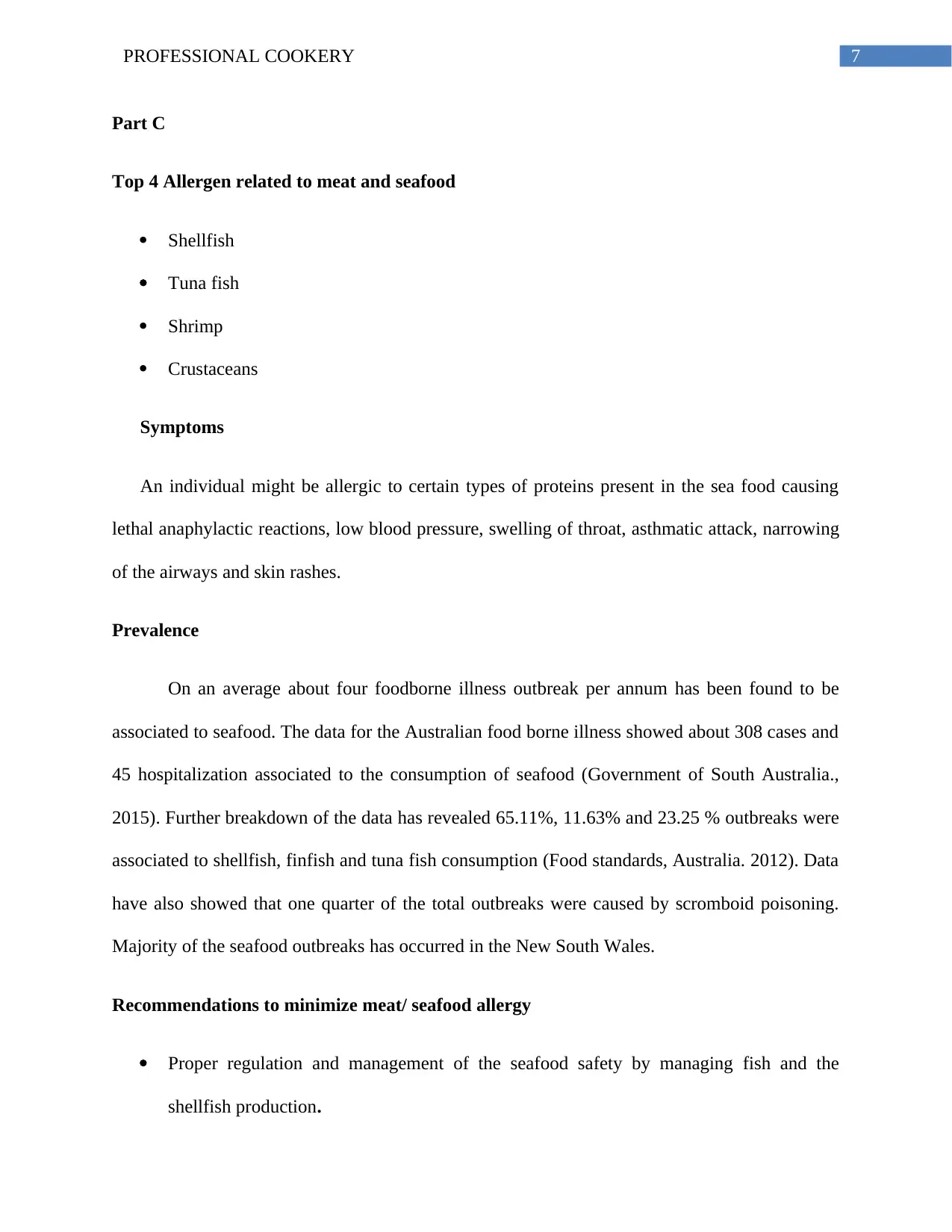
7PROFESSIONAL COOKERY
Part C
Top 4 Allergen related to meat and seafood
Shellfish
Tuna fish
Shrimp
Crustaceans
Symptoms
An individual might be allergic to certain types of proteins present in the sea food causing
lethal anaphylactic reactions, low blood pressure, swelling of throat, asthmatic attack, narrowing
of the airways and skin rashes.
Prevalence
On an average about four foodborne illness outbreak per annum has been found to be
associated to seafood. The data for the Australian food borne illness showed about 308 cases and
45 hospitalization associated to the consumption of seafood (Government of South Australia.,
2015). Further breakdown of the data has revealed 65.11%, 11.63% and 23.25 % outbreaks were
associated to shellfish, finfish and tuna fish consumption (Food standards, Australia. 2012). Data
have also showed that one quarter of the total outbreaks were caused by scromboid poisoning.
Majority of the seafood outbreaks has occurred in the New South Wales.
Recommendations to minimize meat/ seafood allergy
Proper regulation and management of the seafood safety by managing fish and the
shellfish production.
Part C
Top 4 Allergen related to meat and seafood
Shellfish
Tuna fish
Shrimp
Crustaceans
Symptoms
An individual might be allergic to certain types of proteins present in the sea food causing
lethal anaphylactic reactions, low blood pressure, swelling of throat, asthmatic attack, narrowing
of the airways and skin rashes.
Prevalence
On an average about four foodborne illness outbreak per annum has been found to be
associated to seafood. The data for the Australian food borne illness showed about 308 cases and
45 hospitalization associated to the consumption of seafood (Government of South Australia.,
2015). Further breakdown of the data has revealed 65.11%, 11.63% and 23.25 % outbreaks were
associated to shellfish, finfish and tuna fish consumption (Food standards, Australia. 2012). Data
have also showed that one quarter of the total outbreaks were caused by scromboid poisoning.
Majority of the seafood outbreaks has occurred in the New South Wales.
Recommendations to minimize meat/ seafood allergy
Proper regulation and management of the seafood safety by managing fish and the
shellfish production.
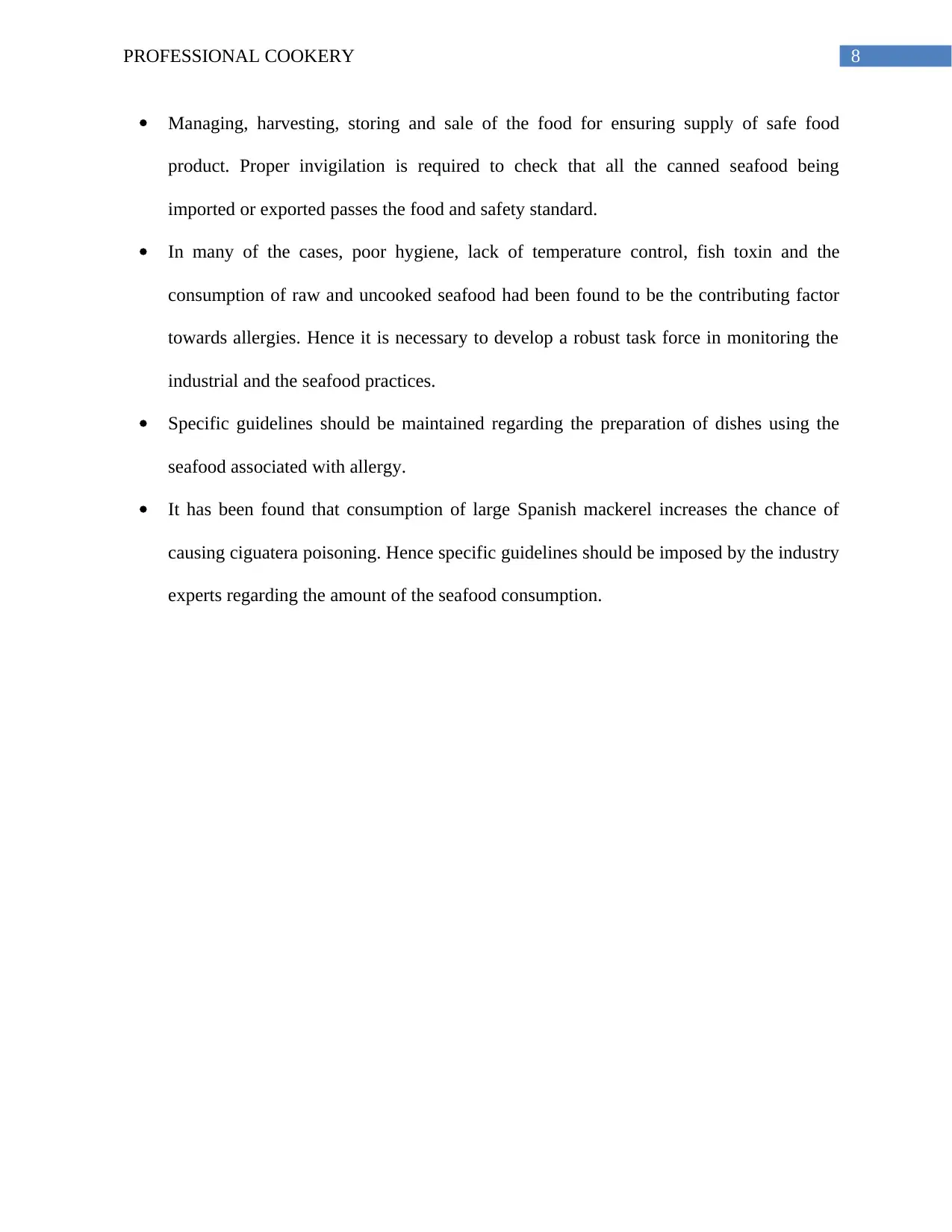
8PROFESSIONAL COOKERY
Managing, harvesting, storing and sale of the food for ensuring supply of safe food
product. Proper invigilation is required to check that all the canned seafood being
imported or exported passes the food and safety standard.
In many of the cases, poor hygiene, lack of temperature control, fish toxin and the
consumption of raw and uncooked seafood had been found to be the contributing factor
towards allergies. Hence it is necessary to develop a robust task force in monitoring the
industrial and the seafood practices.
Specific guidelines should be maintained regarding the preparation of dishes using the
seafood associated with allergy.
It has been found that consumption of large Spanish mackerel increases the chance of
causing ciguatera poisoning. Hence specific guidelines should be imposed by the industry
experts regarding the amount of the seafood consumption.
Managing, harvesting, storing and sale of the food for ensuring supply of safe food
product. Proper invigilation is required to check that all the canned seafood being
imported or exported passes the food and safety standard.
In many of the cases, poor hygiene, lack of temperature control, fish toxin and the
consumption of raw and uncooked seafood had been found to be the contributing factor
towards allergies. Hence it is necessary to develop a robust task force in monitoring the
industrial and the seafood practices.
Specific guidelines should be maintained regarding the preparation of dishes using the
seafood associated with allergy.
It has been found that consumption of large Spanish mackerel increases the chance of
causing ciguatera poisoning. Hence specific guidelines should be imposed by the industry
experts regarding the amount of the seafood consumption.
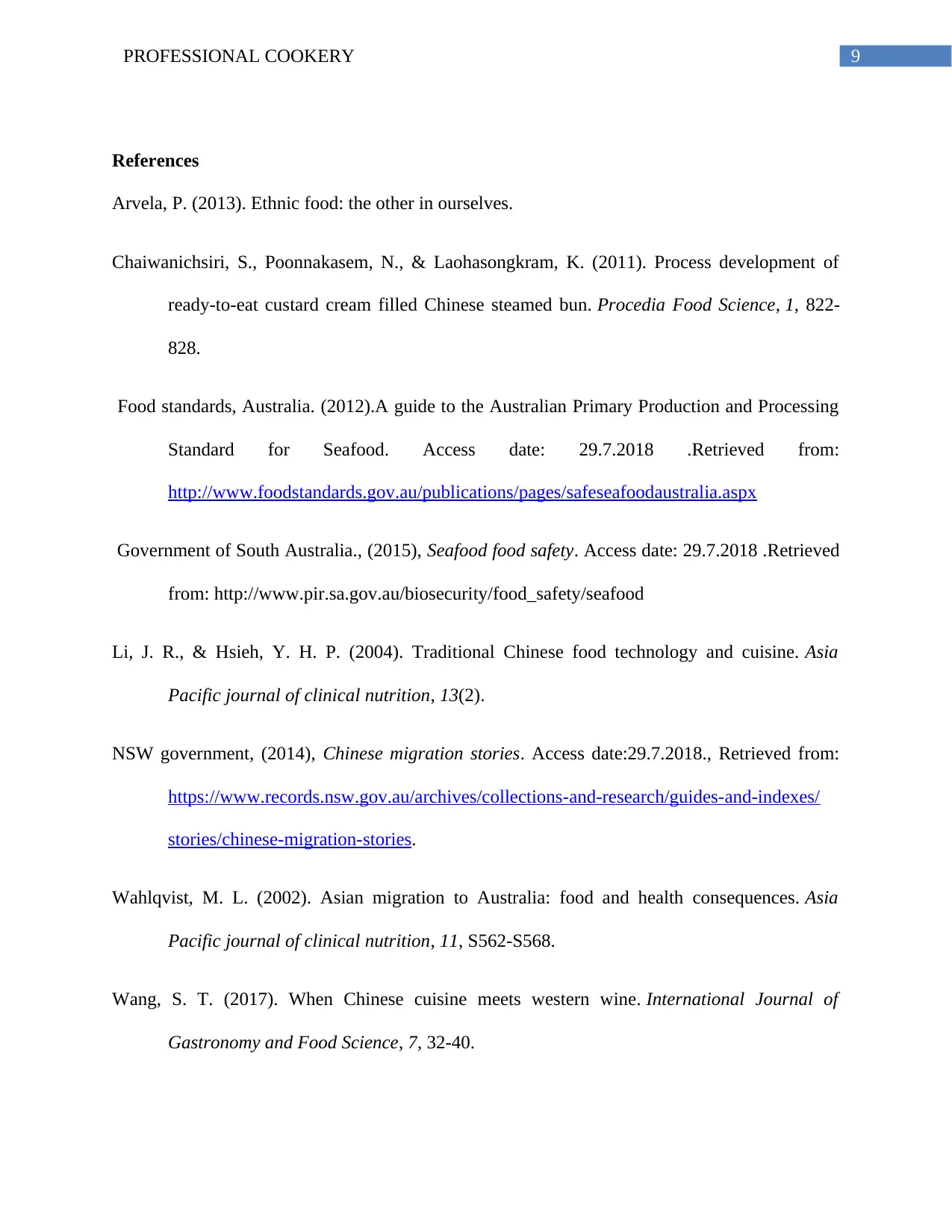
9PROFESSIONAL COOKERY
References
Arvela, P. (2013). Ethnic food: the other in ourselves.
Chaiwanichsiri, S., Poonnakasem, N., & Laohasongkram, K. (2011). Process development of
ready-to-eat custard cream filled Chinese steamed bun. Procedia Food Science, 1, 822-
828.
Food standards, Australia. (2012).A guide to the Australian Primary Production and Processing
Standard for Seafood. Access date: 29.7.2018 .Retrieved from:
http://www.foodstandards.gov.au/publications/pages/safeseafoodaustralia.aspx
Government of South Australia., (2015), Seafood food safety. Access date: 29.7.2018 .Retrieved
from: http://www.pir.sa.gov.au/biosecurity/food_safety/seafood
Li, J. R., & Hsieh, Y. H. P. (2004). Traditional Chinese food technology and cuisine. Asia
Pacific journal of clinical nutrition, 13(2).
NSW government, (2014), Chinese migration stories. Access date:29.7.2018., Retrieved from:
https://www.records.nsw.gov.au/archives/collections-and-research/guides-and-indexes/
stories/chinese-migration-stories.
Wahlqvist, M. L. (2002). Asian migration to Australia: food and health consequences. Asia
Pacific journal of clinical nutrition, 11, S562-S568.
Wang, S. T. (2017). When Chinese cuisine meets western wine. International Journal of
Gastronomy and Food Science, 7, 32-40.
References
Arvela, P. (2013). Ethnic food: the other in ourselves.
Chaiwanichsiri, S., Poonnakasem, N., & Laohasongkram, K. (2011). Process development of
ready-to-eat custard cream filled Chinese steamed bun. Procedia Food Science, 1, 822-
828.
Food standards, Australia. (2012).A guide to the Australian Primary Production and Processing
Standard for Seafood. Access date: 29.7.2018 .Retrieved from:
http://www.foodstandards.gov.au/publications/pages/safeseafoodaustralia.aspx
Government of South Australia., (2015), Seafood food safety. Access date: 29.7.2018 .Retrieved
from: http://www.pir.sa.gov.au/biosecurity/food_safety/seafood
Li, J. R., & Hsieh, Y. H. P. (2004). Traditional Chinese food technology and cuisine. Asia
Pacific journal of clinical nutrition, 13(2).
NSW government, (2014), Chinese migration stories. Access date:29.7.2018., Retrieved from:
https://www.records.nsw.gov.au/archives/collections-and-research/guides-and-indexes/
stories/chinese-migration-stories.
Wahlqvist, M. L. (2002). Asian migration to Australia: food and health consequences. Asia
Pacific journal of clinical nutrition, 11, S562-S568.
Wang, S. T. (2017). When Chinese cuisine meets western wine. International Journal of
Gastronomy and Food Science, 7, 32-40.
Secure Best Marks with AI Grader
Need help grading? Try our AI Grader for instant feedback on your assignments.

10PROFESSIONAL COOKERY
1 out of 11
Your All-in-One AI-Powered Toolkit for Academic Success.
+13062052269
info@desklib.com
Available 24*7 on WhatsApp / Email
![[object Object]](/_next/static/media/star-bottom.7253800d.svg)
Unlock your academic potential
© 2024 | Zucol Services PVT LTD | All rights reserved.


